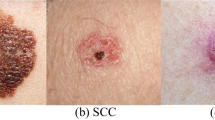Abstract
In this paper we investigate multiple novel techniques of ensembling deep neural networks with different hyperparameters and differently preprocessed data for skin lesion classification. To this end, we have utilized the datasets made public by two of the most recent “Skin Lesion Analysis Towards Melanoma Detection” grand challenges (ISIC2017 and ISIC2018). The datasets provided by these two challenges differ in multiple aspects: the size, quality and origin of the images, the number of possible target lesion categories and the metrics used for ranking. We will show that ensembling can be surprisingly useful not only for combining different machine learning models but also for combining different hyperparameter choices of these models and multiple strategies for preprocessing the input data at the task of skin lesion detection, outperforming more mainstream methods like hyperparameter optimization and test-time augmentation both in terms of speed and accuracy.
Access this chapter
Tax calculation will be finalised at checkout
Purchases are for personal use only
Similar content being viewed by others
References
https://www.skincancer.org/skin-cancer-information/skin-cancer-facts. Accessed 04 Aug 2018
https://challenge2018.isic-archive.com/task2/. Accessed 04 Aug 2018
https://www.cancer.org/cancer/melanoma-skin-cancer/detection-diagnosis-staging/survival-rates-for-melanoma-skin-cancer-by-stage.html. Accessed 04 Aug 2018
http://www.laskerfoundation.org/new-noteworthy/articles/21st-century-healthcare-big-data-medicine/?edit. Accessed 04 Aug 2018
https://isdis.net/about/. Accessed 04 Aug 2018
https://challenge.kitware.com/#challenge/583f126bcad3a51cc66c8d9a. Accessed 04 Aug 2018
https://challenge2018.isic-archive.com/task3/. Accessed 04 Aug 2018
https://github.com/zhixuhao/unet. Accessed 04 Aug 2018
https://www.tensorflow.org/. Accessed 04 Aug 2018
https://keras.io/. Accessed 04 Aug 2018
Chollet, F.: Xception: deep learning with depthwise separable convolutions. In: 2017 IEEE Conference on Computer Vision and Pattern Recognition (CVPR), pp. 1800–1807 (2017)
Codella, N.C.F., et al.: Skin lesion analysis toward melanoma detection: a challenge at the 2017 international symposium on biomedical imaging (ISBI), hosted by the international skin imaging collaboration (ISIC). In: 2018 IEEE 15th International Symposium on Biomedical Imaging (ISBI 2018), pp. 168–172 (2018)
Deng, J., Dong, W., Socher, R., Li, L.J., Li, K., Fei-Fei, L.: Imagenet: A large-scale hierarchical image database. In: 2009 IEEE Conference on Computer Vision and Pattern Recognition, pp. 248–255 (2009)
He, K., Zhang, X., Ren, S., Sun, J.: Deep residual learning for image recognition. In: 2016 IEEE Conference on Computer Vision and Pattern Recognition (CVPR), pp. 770–778 (2016)
Huang, G., Liu, Z., Weinberger, K.Q.: Densely connected convolutional networks. In: 2017 IEEE Conference on Computer Vision and Pattern Recognition (CVPR), pp. 2261–2269 (2017)
Kingma, D.P., Ba, J.: Adam: a method for stochastic optimization. CoRR abs/1412.6980 (2014)
Matsunaga, K., Hamada, A., Minagawa, A., Koga, H.: Image classification of melanoma, nevus and seborrheic keratosis by deep neural network ensemble. CoRR abs/1703.03108 (2017)
Ronneberger, O., Fischer, P., Brox, T.: U-Net: convolutional networks for biomedical image segmentation. In: Navab, N., Hornegger, J., Wells, W.M., Frangi, A.F. (eds.) MICCAI 2015. LNCS, vol. 9351, pp. 234–241. Springer, Cham (2015). https://doi.org/10.1007/978-3-319-24574-4_28
Shi, Z., He, L., Suzuki, K., Nakamura, T., Itoh, H.: Survey on neural networks used for medical image processing. Int. J. Comput. Sci. 3(1), 86–100 (2009)
Simonyan, K., Zisserman, A.: Very deep convolutional networks for large-scale image recognition. CoRR abs/1409.1556 (2014)
Szegedy, C., Ioffe, S., Vanhoucke, V.: Inception-v4, inception-resnet and the impact of residual connections on learning. In: AAAI (2017)
Szegedy, C., Vanhoucke, V., Ioffe, S., Shlens, J., Wojna, Z.: Rethinking the inception architecture for computer vision. In: 2016 IEEE Conference on Computer Vision and Pattern Recognition (CVPR), pp. 2818–2826 (2016)
Tschandl, P., Rosendahl, C., Kittler, H.: The ham10000 dataset, a large collection of multi-source dermatoscopic images of common pigmented skin lesions. In: Scientific data (2018)
Yosinski, J., Clune, J., Bengio, Y., Lipson, H.: How transferable are features in deep neural networks? In: NIPS (2014)
Acknowledgments
The project has been supported by the European Union, co-financed by the European Social Fund (EFOP-3.6.3-VEKOP-16-2017-00002).
We would like to express our special appreciation and thanks to Miklós Sárdy MD, PhD, associate professor (Head of the Department of Dermatology, Venereology and Dermatooncology at Semmelweis University, Faculty of Medicine) for his advice on the diagnosis of skin lesions and to Attila Ulbert PhD for providing part of the hardware infrastructure and his help with the editing of the document.
Author information
Authors and Affiliations
Corresponding author
Editor information
Editors and Affiliations
Rights and permissions
Copyright information
© 2018 Springer Nature Switzerland AG
About this paper
Cite this paper
Nyíri, T., Kiss, A. (2018). Novel Ensembling Methods for Dermatological Image Classification. In: Fagan, D., Martín-Vide, C., O'Neill, M., Vega-Rodríguez, M.A. (eds) Theory and Practice of Natural Computing. TPNC 2018. Lecture Notes in Computer Science(), vol 11324. Springer, Cham. https://doi.org/10.1007/978-3-030-04070-3_34
Download citation
DOI: https://doi.org/10.1007/978-3-030-04070-3_34
Published:
Publisher Name: Springer, Cham
Print ISBN: 978-3-030-04069-7
Online ISBN: 978-3-030-04070-3
eBook Packages: Computer ScienceComputer Science (R0)




